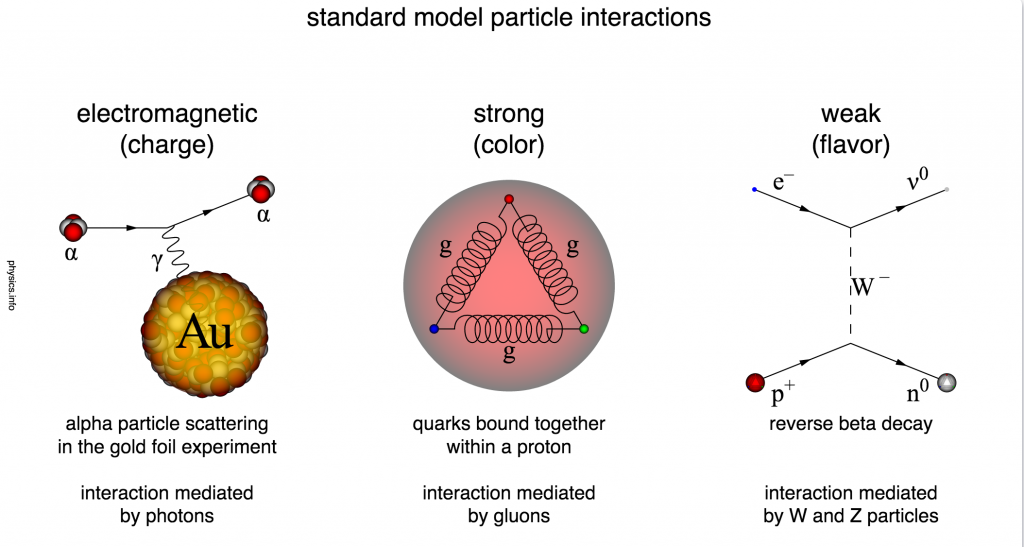Three of the four fundamental fources of nature are included in the standard model of particle physics — electromagnetism, the strong force, and the weak force. (Gravity is not included in the standard model.) Each force acts between particles because of some property of that particle — charge for electromagnetism, color for the strong force, and flavor for the weak force. The bosons associated with each force are called gauge bosons — the photon for electromagnetism, gluons for the strong force, and the W and Z bosons for the weak force.

Charge is the property of matter that gives rise to electric and magnetic phenomena (known collectively as electromagnetism). Charge is quantized, which means it can only exist in discrete amounts with restricted values — multiples and fractions of the elementary charge(e = 1.6 × 10−19 C). Particles that exist independently (the electron, muon, and tau) carry multiples of the elementary charge (−1e), while quarks carry fractions of the elementary charge (+⅔e or −⅓e). Quarks always bind together in groups whose total charge is an integral multiple of the elementary charge, which is why no one has ever directly measured a fractional charge. In addition, since opposite charges attract, electrons tend to bind to protons to form atoms that are neutral overall. We don’t normally notice the electrical nature of matter because of this.
Charged particles interact by the exchange of photons — the carrier of the electromagnetic force. Whenever an electron repels another electron or an electron orbits a nucleus, a photon is responsible. Photons are massless, uncharged, and have an unlimited range. The mathematical model used to describe the interaction of charged particles through the exchange of photons is known as quantum electrodynamics (QED).
Quarks stick to other quarks because they possess a characteristic known as color (or color charge). Quarks come in one of three colors: red, green, and blue. Don’t let the words mislead you. Quarks are much too small to to be visible and thus could never have a perceptual property like color. The names were chosen because of a convenient analogy. The colors of quarks in the standard model combine like the colors of light in human vision.
Colored particles are bound together by the appropriately named gluons. Gluons are also colored, but in a more complicated way than the quarks are. Six of the eight gluons have two colors, one has four, and another has six. Gluons glue quarks together, but they also stick to themselves. One consequence of this is that they they can’t reach out and do much beyond the nucleus.
The mathematical model used to describe the interaction of colored particles through the exchange of gluons is known as quantum chromodynamics (QCD). The whole sticky mess is called the strong force or the strong interaction since it results in forces in the nucleus that are stronger than the electromagnetic force. Without the strong force, every nucleus would blow itself to smithereens.
